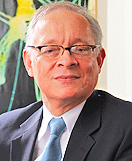News
UB receives federal stimulus funding
-
 Print
Print -
 Comments
Comments
-

“The federal government’s multi-billion dollar investment has been a boon to higher education because it supports the research pursuits of universities like UB, which in turn stimulates local economies, such as Western New York’s, that are impacted by university research.”
UB has received $18.7 million in federal stimulus funding for 58 research awards since Congress enacted the American Recovery and Reinvestment Act of 2009 (ARRA) in February.
During a visit to the National Institutes of Health (NIH) last week, President Barack Obama announced the $5 billion in grants that NIH has awarded to universities and research institutes across the nation to support critical research while simultaneously stimulating local economies. UB is one such recipient of these funds, to date receiving $18.7 million in awards through ARRA—$11.6 million from 41 NIH awards and $7.1 million from 17 National Science Foundation (NSF) awards.
“From the beginning, our goal has been to rescue the economy at the same time as we're laying a new foundation for lasting economic growth,” Obama said.
ARRA funding is intended to stimulate the national economy by making funds available for job creation and retention, infrastructure investment, education, energy efficiency, health research and assistance to the unemployed in states across the nation. According to the White House, research grants are part of ARRA’s overall investment of $100 billion to innovative research and advancing science and technology infrastructure.
The $5 billion in NIH funding represents “the single largest boost to biomedical research in history,” Obama said.
Jorge V. José, UB vice president for research, explains that the federal government’s multi-billion dollar investment “has been a boon to higher education because it supports the research pursuits of universities like UB, which in turn stimulates local economies, such as Western New York’s, that are impacted by university research.”
“ARRA stipulates that its grant resources are to be leveraged for economic impact in local communities and must help to improve quality of life, and for accelerating critical scientific research,” says José. “Having an impact on regional workforce creation is also considered to be part of this objective. UB’s ARRA-funded research meets each of these objectives.”
For example, John M. Canty, chief of UB’s Division of Cardiovascular Medicine, was awarded $2 million through ARRA to purchase a sophisticated cardiovascular PET/CT scanner that will be used by UB researchers to study the underlying causes of heart disease and stroke.
“Heart disease continues to be one of the leading causes of death and disability,” says Canty, the Albert and Elizabeth Rekate Professor of Medicine at UB.
“This new scanner will advance UB’s discovery of potentially relevant therapies by focusing on the translation of research from the preclinical to clinical stages.”
NIH officials also stressed how funding basic research was a wise economic investment. Former acting NIH Director Raynard Kington estimated that each dollar invested by the NIH stimulates $2.50 in associated economic activity.
Among the UB researchers and projects being funded through ARRA:
• Sarbajit Banerjee, assistant professor of chemistry, has received a NSF CAREER award, the NSF’s “most prestigious award in support of junior faculty who exemplify the role of teacher-scholars through outstanding research and excellent education.” The award will look at how nanoscale materials, which often show properties that are not exhibited by their bulk counterparts, can be harnessed for practical applications, such as making faster electronic circuits for use in the next generation of computers, “smart” window materials that change color with temperature and accurate sensors for detecting low concentrations of vapors.
• Jean Wactawski-Wende, vice provost for strategic initiatives and professor of social and preventive medicine, and colleagues in the School of Dental Medicine were awarded an NIH “challenge grant.” These grants are designed to address specific scientific and health research challenges in biomedical and behavioral research that will benefit from significant two-year jumpstart funds. The research in these areas should have a high impact in biomedical or behavioral science and/or public health. Wactawski-Wende and her colleagues are looking at saliva and serum inflammatory biomarkers in periodontitis in older women.
• Cynthia Dlugos, research assistant professor of pathology and anatomical sciences, is studying the imbalances in calcium homeostasis (dynamic metabolic equilibrium) through alcohol-related nerve degeneration. Recent studies show that consistent, albeit moderate, alcohol consumption in human adults results in permanent alterations in cerebellar-based motor coordination, as well as in the cognitive activities ascribed to the cerebellum's connections with the frontal lobe. Permanent deficits resulting from these alterations become more prevalent with age and predispose an increasing elderly population to falls, accidents and cognitive dysfunctions.
• Ia Iashvili, assistant professor of physics, has received support for a long-term research program in collider physics that will foster collaboration between UB, high school teachers and their students.
• Ezra Zubrow, professor of anthropology, is working with Russian scientists to study the past and potential range of human resilience when faced with global and local environmental changes in order to aid policymakers in decisions regarding energy, post-colonial governance and strategy.
• Saul Greenfield, clinical associate professor of urology, received supplemental funds in support of his randomized, multi-institutional clinical trial of girls with vesicoureteral reflux (VUR) after a urinary tract infection. It is estimated that as many as 50,000 children are diagnosed with VUR annually in the U.S.

Reader Comments